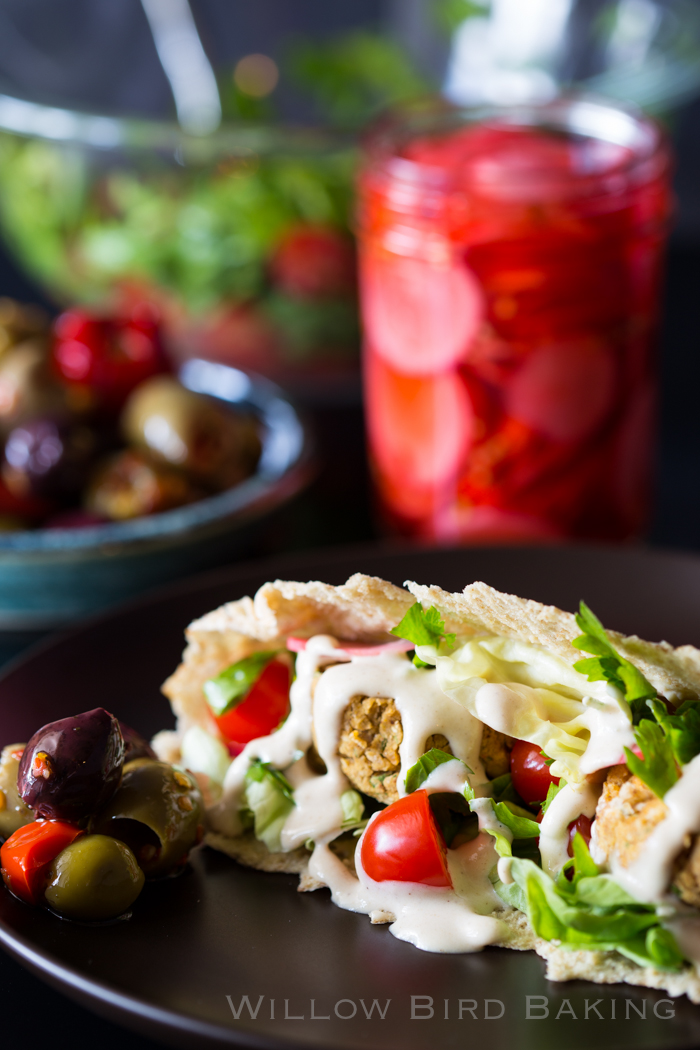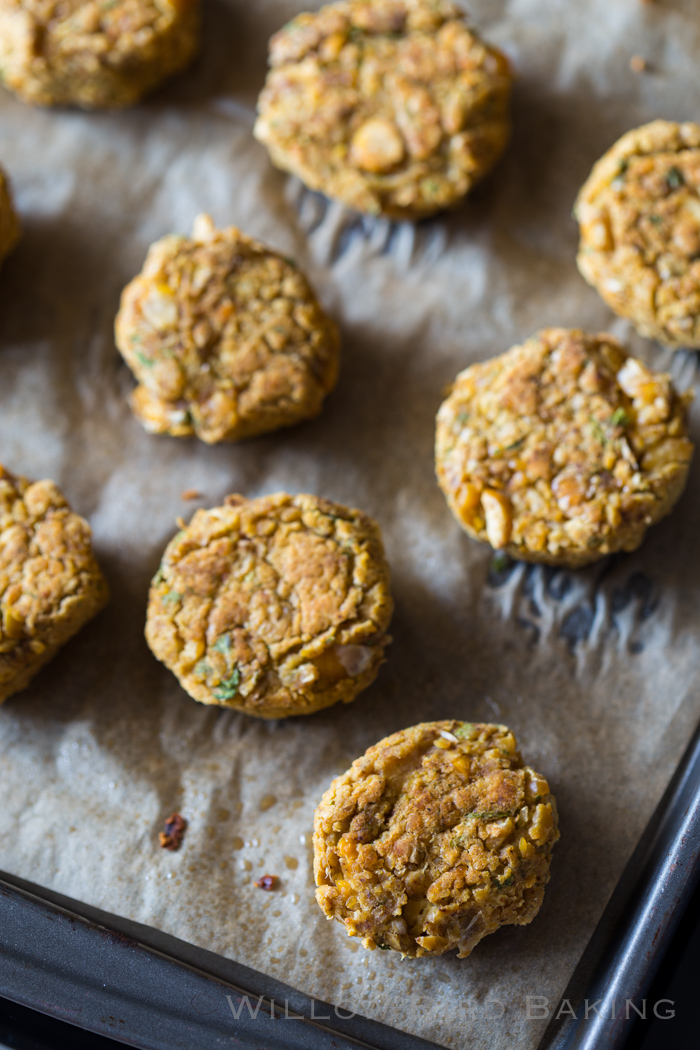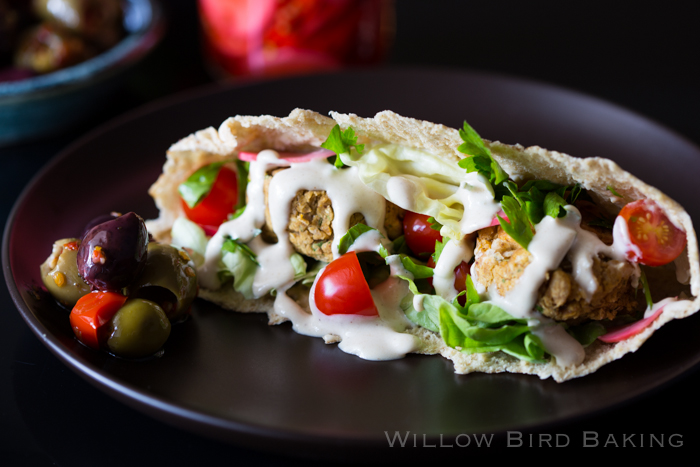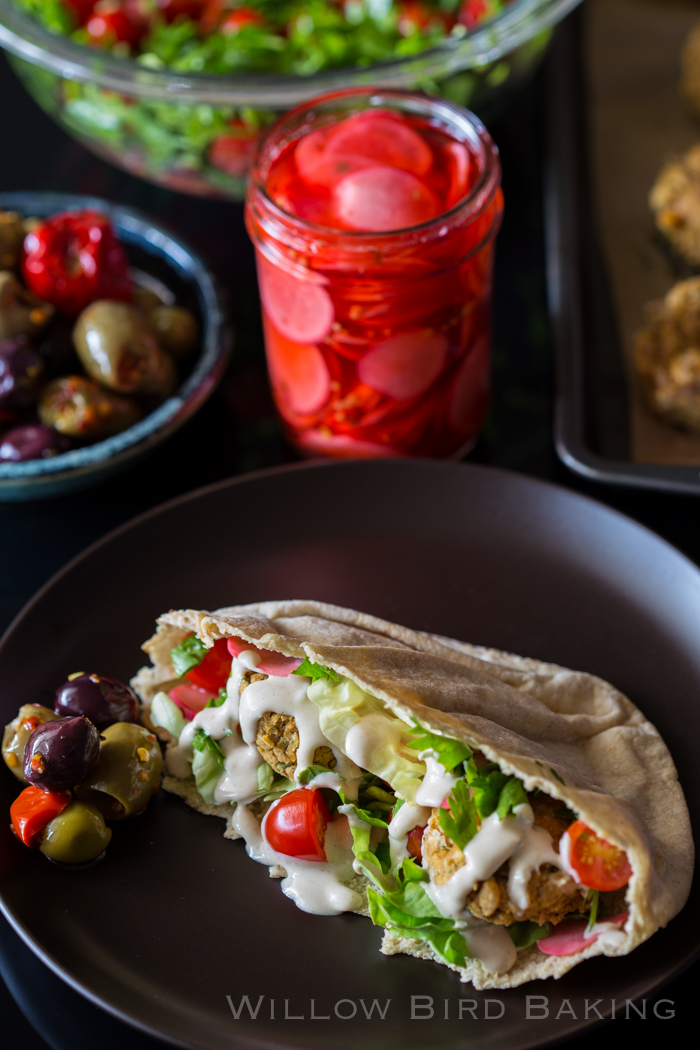
Fully Loaded Baked Falafel Pita
Welcome to the second post in my series about anti-racism for white people: Identifying and Dealing With White Fragility. Thank you to all of you made a commitment to read at least the first two posts! (Here’s the first one if you missed it.) At the end of this installment, you’ll find the dinner recipe that Mike and I are currently crazy about, which happens to be a great way to use the quick-pickled radishes I posted last week: an (incidentally vegan) Fully Loaded Baked Falafel Pita! You’ll also have a chance to share your experiences and resources in the comments. Let’s begin in a rather unlikely place: the skating rink.
When I was 8, I broke my arm at the skating rink. I’ve told you the story before, but I want to focus in on one aspect of it. I was rude to the concession stand cashier when he wouldn’t give me ice to put on my injury, and my friend encouraged me to apologize to him. I want to focus in on the feelings I went through in that moment, which consisted of discomfort, pride, indignation, anger, humiliation, defensiveness, and guilt.
Discomfort because I was in a pickle and I had to either back down or continue fighting; the former felt embarrassing while the latter felt stupid and scary. Pride and indignation because I had just sassed this dude to stand up for myself and now I didn’t want to back down. Anger because I felt like he should’ve given me the ice, which would’ve prevented all of this discomfort in the first place. Humiliation because deep down, I knew I was going to have to admit I had been rude. Defensiveness because part of me was still insisting that I hadn’t been rude: HE had been rude and I had just defended myself! I knew because my feelings were hurt and why would they be hurt if he hadn’t hurt me? Guilt because underneath all of my swirling feelings was the understanding that I had done something wrong.
All of these feelings were valid. Feelings aren’t right or wrong, but they require some analysis to interpret. And it wasn’t the concession guy’s job to sort through them and arrive at a place where I could make an effective decision about what to do — it was mine. What does this have to do with racism?

A phenomenon that is common among even the absolute best-intentioned, good-hearted white people, bless our hearts, is something called “White Fragility.” A friend of mine recently said she feels like it’s the single biggest impediment to us as we try to dismantle racist systems. I’ve experienced it in myself and seen it in others, so perhaps you have too. It’s a surge of feelings — discomfort, pride, indignation, anger, humiliation, defensiveness, and guilt — we sometimes get when we’re reading or participating in a conversation about racism and something strikes us as a personal offense. Here are some times you might have experienced it:
- Someone uses the term “white privilege” and you feel like they are presuming things about you because you are white, or trying to make you feel guilty for something that isn’t your fault.
- Someone discussing racism uses the phrase “white people” and you feel lumped in unfairly.
- Someone recounts a time they experienced racism and you feel accused.
- Someone says, “Black Lives Matter,” and you feel the phrase is excluding you.
- Someone is discussing racism and you feel that talking about it creates controversy where there otherwise wouldn’t be any.
- Someone tells you that something you said or did was racist and you feel hurt and misunderstood.
- Someone shares how they view an event or symbol as racist and it doesn’t match how you’ve always seen it, so you feel defensive.
I could go on. There are lots of times where you might feel that sudden mix of complicated feelings. But a good rule of thumb for life (not just for being anti-racist) is to insert space between your emotions and your reactions. Your emotions are valid, meaning anyone in your situation with your past and your personality and your context might experience them. But that doesn’t mean they are justified or that your interpretation of them is correct. In my skating example, my anger and humiliation was valid, but my interpretation (“That guy is making me have this uncomfortable experience! It’s his fault because he was mean to me!”) was incorrect. If I had immediately acted on that interpretation and continued to be a little snot, I would have sabotaged myself and my cause (getting some flippin’ ice).

There are many reasons these feelings come up for us as white people. It is crucial to confront them because they can cause us to shut down or fight in the wrong direction instead of fighting racism itself. I’m writing this as the second post in this series because none of what will follow will be effective if we let discomfort, pride, indignation, anger, humiliation, defensiveness, and guilt shut us down. We can feel them, but we have to know what to do when we feel them. So here’s my humble prescription as a fellow white person who has had to figure this out:
Step 1: HUMBLY READ. With an open mind and heart, read this article and this article about the phenomenon of White Fragility and why we experience it (additional resources are listed below, but I think these two are critical reads). When I read these articles, I recognized so many of these things were true about myself. For instance, I have never regularly experienced racial discomfort, so when racism — an inherently uncomfortable topic — comes up, I do instinctively feel like that’s a conversation I should be able to “opt out” of, even though for so many people, addressing the topic is vital to their wellbeing. I also feel “a deeply internalized, largely unconscious sense of racial belonging in U.S. society” in that I always feel like I’m “default.” I can forget my race entirely as I go about my daily life not because I’m some kind of post-racial superstar, but because our society was built for the comfort of my race! Eep. This background reading will prep you to do the rest of these steps when you feel those uncomfortable feelings.
Step 2: MINDFULLY PAUSE. Commit to putting distance between your emotions and reactions. The first step of doing that is to take a break to breathe deeply and identify your feelings. Close your eyes and mentally scan your body. Do you have a racing heartbeat, tight chest, and shallow breaths, which might tell you that you are anxious or angry? Are your muscles tensed in defense? Do you feel the surge of adrenaline that might be associated with the urge to attack or stubbornly stand your ground?
Step 3: CAREFULLY EXAMINE. Once you know what feelings you’re feeling, identify what interpretations and assumptions are creating those feelings in you. This is why it was so critical to read the articles linked in Step 1 about White Fragility — because often the things creating the emotions in us are things we will want to challenge in ourselves! Other times we will realize that the assumptions we’re making aren’t warranted.
Step 4: WILLINGLY LEARN. Seek out resources to assist you in managing your negative emotions without lashing out at or putting an undue burden on people of color to educate you. Google, come here to ask for help finding resources, or chat with supportive friends who you know are on the same journey as you.
Step 5: THOUGHTFULLY ACT. Now that you’ve learned more about the situation you’re encountering and aren’t just reacting, decide how best to proceed. What response on your part will prioritize the goal of dismantling racism?

To illustrate how these steps might assist us in dealing with our White Fragility, let me offer two scenarios:
Scenario 1: I see my friend Erica tweet with the hashtag #BlackLivesMatter. I want to make that even broader — it seems a little narrow to me to just say Black lives matter. I want my tweet to encompass all the bad things happening to people around the world. I think the best way to do that is to tweet back #AllLivesMatter. Erica tells me that hashtag is racist. I’m furious!
I immediately defend myself by tweeting back, “How dare you call me racist when you’re the one whose hashtag only included one race!” And then I accuse her by tweeting, “I don’t care what race anyone is. I don’t even think that way! I care about ALL lives, not just some. If you’d stop creating divisions like this between races, maybe we wouldn’t have so many problems!” Erica blocks me, which compounds my frustration and pain. Afterwards, I feel even more of a reflexive urge to defend, argue, and lash out when I see folks discussing racism.
Scenario 2: I see my friend Erica tweet with the hashtag #BlackLivesMatter. I want to make that even broader — it seems a little narrow to me to just say Black lives matter. I want my tweet to encompass all the bad things happening to people around the world. I think the best way to do that is to tweet back #AllLivesMatter. Erica tells me that hashtag is racist. I’m furious!
I recognize this strong emotion in me as a red flag, so I close my computer and go sit in a comfy spot. I close my eyes and take a deep breath, scanning my body. My heart rate is high and my jaw is clenched. I recognize that I’m feeling angry, hurt, and defensive. I examine what interpretations are producing these feelings in me. I realize that I’m angry because I feel like Erica is calling me racist, and I know that I have a good heart and love people. It bothers me so much to be called racist! But now that I think of it, Erica didn’t call me racist — she said that hashtag was racist. I wonder why she feels that way. I tuck these thoughts away and move on to the next feeling. I’m feeling hurt because Erica is my friend and it’s hard when it feels like she’s not on the same team as me. But if that hashtag really is racist somehow, maybe she feels the same — hurt because I said something that makes it feel like I’m not on her team. I feel defensive because I hate for anyone, especially Erica, to think that I’m racist. I try hard to be a good person and I want people to know that I am! But . . . well, now that I’m thinking about it, maybe the best way to be a good person in this situation is to look into the hashtag, find out if it really is racist somehow, and if so, to stop using it.
I feel calmer now and I also feel like I am open to Erica’s point of view. I open my computer back up to do some research. I google, “Is saying #AllLivesMatter racist?” and find these tweets and this one and this comic. I find that someone defaced artwork intended to memorialize Sandra Bland with the message #AllLivesMatter, underscoring the phrase’s inimical tone. Oh wow. I now understand what Erica meant and feel so thankful I didn’t react immediately and stick my foot even farther in my mouth. I delete my #AllLivesMatter tweet and then message Erica: “I’m so sorry about that — I had no idea! Thanks for telling me so that I could look into it.” Now when I see folks discussing issues in racism I’m not familiar with, I remember this exchange, stay humble, and do some research before chiming in.
When we let ourselves lash out and shut down because we experience feelings we don’t like, we lose the opportunity to grow, build connections, and actively love other people. And remember: when talking about racism, we will often experience feelings of discomfort and pain because we are so used to being able to opt right out of these uncomfortable conversations! But the stakes are too high in our nation now for us to choose that easy way out. Please commit to not letting yourself turn a blind eye to these issues just because you can.
Next time you feel the surge of negative emotions associated with White Fragility, remember: mindfully pause, carefully examine, willingly learn, and thoughtfully act.
Here are excellent resources on this topic:
Transforming White Fragility into Courageous Imperfection
Getting Called Out: How to Apologize
In the comments below, please: (A) share a situation recently where you have had to manage your own reaction in order to be an effective ally against racism, (B) share a situation where you WISH you would have done so, (C) ask honest questions without fear of “saying the wrong thing,” and/or (D) share anti-racism resources that you have found valuable.
One year ago: Hot Raspberry Cake with Vanilla Ice Cream
Two years ago: Strawberry Lemonade Cheesecake Bars with a Shortbread Crust
Three years ago: Shredded Wheat or Weetabix Breakfast Scramble
Four years ago: Soft Sugar Cookies
Five years ago: Spicy Peach and Cucumber Salsa
Six years ago: Overnight Yeast Rolls

- 2 (15-ounce) cans chickpeas, rinsed and drained
- 3 tablespoons flour
- 3 tablespoons fresh parsley
- 4 cloves garlic, minced
- 2 teaspoons ground cumin
- 2 teaspoons ground coriander
- 1 teaspoon chili powder
- 1/2 teaspoon salt
- 1 dash freshly ground black pepper
- 1 1/2 cups cherry tomatoes, halved or quartered
- 1 1/2 cups chopped fresh parsley
- 1/2 cup lemon juice
- 1 cup tahini
- 3 cloves minced garlic
- 1/4 cup lemon juice (plus more to taste)
- heaping 1/4 teaspoon salt (plus more to taste)
- 1 cup lukewarm water, or more for consistency
- pita bread
- roasted garlic hummus
- butter lettuce
- quick-pickled radishes
- Make the falafel: Line a baking sheet with parchment paper and preheat the oven to 400 degrees F. Place all the ingredients in the food processor and pulse until well combined, scraping the sides every now and then. Form the mixture into patties that are about 1 1/2-inch in diameter and about 1-inch thick and place them on prepared pan. Bake for 15-20 minutes, gently turning once halfway through. While they bake, prepare the other items.
- Make the tomato-parsley salad: Mix the tomatoes, parsley, and lemon juice together and set in the fridge to marinate.
- Make the tahini sauce: Place all ingredients except water in the food processor and process until smooth. Add the water to reach the consistency you desire (a liquidy sauce is ideal for drizzling over pita pockets.) Taste and add more salt or lemon juice if needed. Set this aside.
- Assemble the pockets: Split the pitas in half and open the pocket. Smear the inside of the pocket with roasted garlic hummus and line with butter lettuce. Fill with two falafel, several pickled radish slices, a scoop of tomato-parsley salad, and a heavy drizzle of tahini sauce. Serve immediately.
16 Comments on Fully Loaded Baked Falafel Pita (vegan) and Anti-Racism for White People (Post 2)
1Pingbacks & Trackbacks on Fully Loaded Baked Falafel Pita (vegan) and Anti-Racism for White People (Post 2)
-
[…] This recipe comes from the blog Willow Bird Baking. […]

ro
August 3, 2015 at 1:27 am (10 years ago)I’m a POC and I love that you’re doing this series. It’s really excellent to read and see, and I appreciate your humility, compassion and courage. I appreciate you, Julie.
I would like to share an article, actually. If I could attach it, I would. It’s an academic article, written by Camara Jones, who is an MD/PHD/MPH, and is a researcher on social determinants of health. I like this article because it’s not very jargony and is appropriate even for non-academics to read. It’s about differing levels of racism.
It’s called “Levels of Racism: A Theoretic Framework and a Gardener’s Tale.” I believe you can access the pdf here: http://www.citymatch.org/sites/default/files/documents/bookpages/JonesGardenersTale.pdf
Please let me know if you’d like to read it but can’t find it. I can send you the PDF. It’s only a few pages long but is one of the most influential works I’ve read in my entire academic career.
Julie Ruble
August 3, 2015 at 10:05 am (10 years ago)Thank you so much for your kind words and the article, Ro! I haven’t read this one yet and it looks really helpful. It also previews the next post (which discusses systemic vs. individual racism). And there’s an allegory/parable! My favorite! Thanks again.
ro
August 4, 2015 at 12:19 am (10 years ago)No problem. I would be interested to hear your thoughts on it, as it’s forming the basis on which my dissertation is focused. Feel free to email me if you like it (or not), I’d love to hear your thoughts!
Jenni
August 3, 2015 at 10:58 am (10 years ago)I am so glad you are writing this series, Julie. I have only just come in on this, your second post, but I will go back and read the first and look for the rest to come.
I remember when the riots were happening in Ferguson and a friend and neighbor was talking about not understanding why “they” were so angry and that “their” behavior was shameful. On one level, I could see her point, but on another deeper level, I had to say that it was absolutely impossible for white people to know what it feels like to be scrutinized and met with suspicion day in and day out. To be followed around in a store. To be ticketed “for being black.” You can only push that anger and frustration down inside for so long.
Like a strong tea, we are steeped in the institutionalized racism in our country, and it takes a huge effort to see beyond that. And yes it’s uncomfortable, and yes it makes white people defensive and sweaty. But these are the conversations we must have if we are ever to recognize this racism, concede that it is unfair to say the least, and try to heal the raw wounds that have festered for centuries. Thank you for leading this one.
Kimberly @ The Daring Gourmet
August 3, 2015 at 11:09 am (10 years ago)I participated in a study abroad program in Jerusalem a number of years ago and the area is literally dotted with falafel shops. They’re as common there as fast food joints are here. I’ve been a huge fan ever since and yours looks absolutely amazing!
Kelley
August 3, 2015 at 5:01 pm (10 years ago)I LOVE falafel, and love the fact these are baked, not fried! yummy!
Meg @ NomingthruLife
August 3, 2015 at 9:22 pm (10 years ago)I don’t want you to think I’m dismissing your article on anti-racism, but I have to just get right to it… I’m in LOVE with these falafels 🙂 And that they are fully loaded… swoon *faint* 🙂
Thalia @ butter and brioche
August 3, 2015 at 11:18 pm (10 years ago)How delicious. I love a good falafel.. especially when it’s accompanied by as much delicious sauce and in pita like this.
Linda
August 4, 2015 at 12:20 am (10 years ago)I’ve only read your first sentence–I’m working tonight, but I have to tell you that we have something in common other than our love for cooking and baking. I also broke my arm skating when I was 8. I was in a roller rink and I was with my father who took me to a doctor immediately so I didn’t ask anyone for ice. Some coincidence, wouldn’t you say?
Julie Ruble
August 4, 2015 at 12:25 am (10 years ago)Yes, quite the coincidence! My dad took me to the doctor and saved the day as well 🙂 Post-ice, of course.
Christie
August 4, 2015 at 7:03 am (10 years ago)I failed at falafel. This? This look fabulous!! I will have to try your recipe because mine just didn’t hold up.
Glen
August 14, 2015 at 6:56 pm (10 years ago)Thank you for this series.
We are so steeped in systemic racism and sexism that sometimes even those of us who like to think “we’re better than that” still do and say racist and sexist things. I can’t for the life of me remember what I said (obviously something I took for granted as a white person), but I will always remember the look on my Asian husband’s face when he responded “uhm, honey, I’m not Caucasian….” And I know I felt like Such. An. Idiot. So I keep stretching to be a better person. It’s up to each of us, in our shared humanity, to discover and acknowledge our (deeply) unconscious biases and work hard to eradicate their effects on others.
Elizabeth B.
August 16, 2015 at 5:13 pm (10 years ago)Thank you for starting this discussion. I am still trying to figure out how to handle a situation that came up for me earlier this week. A representative of a national retailer was at my family home giving me an estimate on work to be done. When I made a comment about their appointment scheduler not knowing how to pronounce the unfamiliar place names in our address, he asked if she had a “really dark tan.” I was stunned and speechless…and I’m sorry to say that I did nothing in the moment. I’m not going to let this go by unnoticed (and I will be in communication with his home office). I was so surprised that someone so casually said this to someone whom he had never met before. Because a comment like this is just the tip of the iceberg of what his true feelings may be.
Julie Ruble
August 16, 2015 at 5:18 pm (10 years ago)Oh dear. I’m glad you’re thinking of being in touch — I hope that his employer takes this opportunity to provide quality diversity training. So much diversity training is throwaway stuff, but I’m hoping that businesses are realizing the absolutely critical role diversity plays in their practices in a global economy.
lindsay
August 21, 2015 at 11:20 am (10 years ago)thanks so much for writing about this. i’ve been shocked by how many of the white lifestyle/food/style bloggers i follow have remained entirely silent on race lately. even if it’s not your blog’s “topic”, if you have a platform from which to spread awareness, i think you’re obligated to do so, even if it’s just sharing a few links (ideally to articles by writers of color). so thanks for stepping up to the plate.